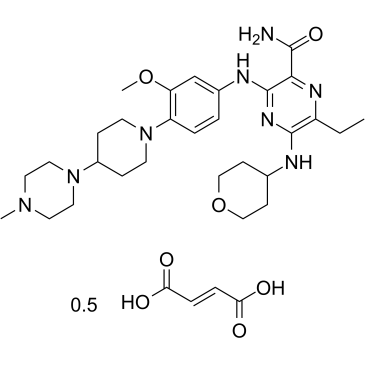Gilteritinib hemifumarate (Synonyms: ASP2215 hemifumarate) |
| Catalog No.GC36135 |
Gilteritinib (ASP2215) hemifumarate is a potent and ATP-competitive FLT3/AXL inhibitor with IC50 of 0.29 nM/0.73 nM, respectively.
Products are for research use only. Not for human use. We do not sell to patients.

Cas No.: 1254053-84-3
Sample solution is provided at 25 µL, 10mM.
Gilteritinib hemifumarate is a potent FLT3/AXL inhibitor with IC50 of 0.29 nM/0.73 nM, respectively. IC50: 0.29 nM (FLT3)[1]IC50: 0.35 nM (LTK), 0.73 nM (AXL), 1.2 nM (EML4-ALK), 230 nM (c-KIT)[2]
Of the 78 tyrosine kinases tested, Gilteritinib (ASP2215) inhibits FLT3, leukocyte tyrosine kinase (LTK), anaplastic lymphoma kinase (ALK), and AXL kinases by over 50% at 1 nM with an IC50 value of 0.29 nM for FLT3, approximately 800-fold more potent than for c-KIT[1]. Gilteritinib inhibits the activity of eight of the 78 tested kinases by over 50% at concentrations of either 1 nM (FLT3, LTK, ALK, and AXL) or 5 nM (TRKA, ROS, RET, and MER). The IC50s are 0.29 nM for FLT3 and 0.73 nM for AXL. Gilteritinib inhibits FLT3 at an IC50 that is approximately 800-fold more potent than the concentration required to inhibit c-KIT (230 nM). The antiproliferative activity of Gilteritinib is evaluated against MV4-11 and MOLM-13 cells, which endogenously express FLT3-ITD. After 5 days of treatment, Gilteritinib inhibits the growth of MV4-11 and MOLM-13 cells with mean IC50s of 0.92 nM (95% CI: 0.23-3.6 nM) and 2.9 nM (95% CI: 1.4-5.8 nM), respectively. Growth suppression of MV4-11 cells is accompanied by inhibition of FLT3 phosphorylation. Relative to vehicle control cells, phosphorylated FLT3 levels are 57%, 8%, and 1% after 2 h of treatment with 0.1 nM, 1 nM, and 10 nM Gilteritinib, respectively. In addition, doses as low as 0.1 nM or 1 nM result in the suppression of phosphorylated ERK, STAT5, and AKT, all of which are downstream targets of FLT3 activation. To investigate the effects of Gilteritinib on AXL inhibition, MV4-11 cells that expressed exogenous AXL are treated with Gilteritinib. At concentrations of 1 nM, 10 nM, and 100 nM for 4 h, Gilteritinib treatment decreases phosphorylated AXL levels by 38%, 29%, and 22%, respectively[2].
In MV4-11 xenografted-mice, the concentration of Gilteritinib (ASP2215) in tumors is more than 20-fold higher than that in plasma with oral administration of Gilteritinib at 10 mg/kg for 4 days. Treatment of Gilteritinib for 28 days results in dose-dependent inhibition of MV4-11 tumor growth and induces complete tumor regression at more than 6 mg/kg. Further, Gilteritinib decreases tumor burden in bone marrow and prolonged the survival of mice intravenously transplanted with MV4-11 cells[1].
[1]. ASP2215, a novel FLT3/AXL inhibitor: Preclinical evaluation in acute myeloid leukemia (AML). 2014 ASCO Annual Meeting. [2]. Mori M, et al. Gilteritinib, a FLT3/AXL inhibitor, shows antileukemic activity in mouse models of FLT3 mutated acute myeloid leukemia. Invest New Drugs. 2017 Oct;35(5):556-565.
Average Rating: 5 (Based on Reviews and 37 reference(s) in Google Scholar.)
GLPBIO products are for RESEARCH USE ONLY. Please make sure your review or question is research based.
Required fields are marked with *




















